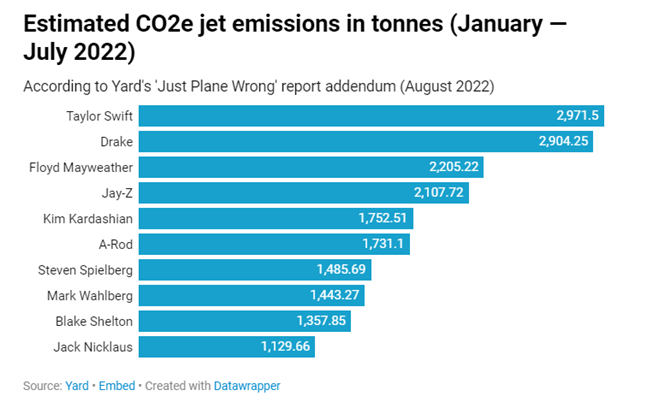The one in which I speak about Snakes on a Plane
Right... Snakes on a Plane. Sorry, I’m not talking about the truly wild 2006 cult-classic. If you’re too young to know about that film, I highly recommend reading the plot-line on Wikipedia, you really won’t regret it. Unfortunately, we have to leave Samuel L. Jackson and his iconic lines out of this. Partly because I have a word-count to stick to, and partly because it’s Samuel L. Jackson, so the language is far too colourful for this platform.
Instead, I’ll be
talking about the snakes of capitalism, and the debate around liability of airplane emissions. Some
of the richest countries, corporations, and individuals refuse to take responsibility
for their mile-high CO2 emission bills.
Sorry Swifties, but Taylor is ranked as the number one perpetrator on this list of celebrities’ CO2 jet emissions (that’s just in one half of the year, there’s still more than a year left of the Eras Tour).
Yes, this
picture looks bad for Taylor Swift, but I’d also like to add that self-styled ‘saviour
of the human race’, Elon
Musk, sometimes takes a 9 minute flight on his private jet… a distance he could do in less
than an hour in one of his zero-emission Tesla’s. Tesla – which “exists to help
reduce the risk of catastrophic climate change, which affects all species on
Earth.”, according to a 2018 Tweet from
Musk. I’m laughing, but not in a good way. In general, there’s a blatant
disregard for the state of the climate from most private jet users. To put it
in perspective: on a flight from New York to
Washington, a private jet emits roughly 3500kg of CO2 per passenger, whilst
a commercial plane emits about 80kg per passenger. My goodness, the irony of a
commercial flight user being asked to pay a little extra on their airfare to ‘offset their carbon footprint’.
Now, please don’t think I’m against people understanding and offsetting their individual carbon footprint. I think being aware of your personal contribution to climate change is important – kind of like the opposite to ‘ignorance is bliss’. Here is a very cool personal carbon footprint calculator to try. Be prepared to feel guilty… According to this, if everyone on the planet lived like me, we’d need 3.1 Earth’s to sustain us…
But really, this is where I bring in the Snakes on a Plane reference. Multi-billion dollar airlines are greenwashing you, making it seem like you, the consumer, are responsible for the massive amounts of carbon dioxide emitted by their aircraft. And while they're guilt-tripping you, they seem to be doing very little in the way of actually reducing their carbon contributions. It would be like Eskom asking us to pay braai tax.
Overall, aviation accounts for 2.5% of CO2 emissions, which translates to 3.5% of the effective radiative forcing. I know, that doesn’t sound all that bad. But, what concerns me is this: that 2.5% contribution has remained pretty stable in the last 60 years. The International Air Transport Association states that the aviation industry improved their fuel efficiency by 1.5% per year between 2009 and 2020. Wow… Surely, we could do better than that? I mean the internet only started in 1983, and look how far we’ve come since then. This entire blog post could have been written by an AI platform on the internet (it was not – sorry ChatGPT, but you’re not capable of an existential crisis and therefore do not possess nearly as much cynicism as me). So, my question is, are the airlines really doing enough to decrease their emissions, and are they doing it fast enough? Or is it a classic case of capitalism over climate?
Which brings me on to my next question… who is responsible for the carbon tax on international flights? The consumer? The country to which the airline is registered? The country from which the flight departs, or the country in which the flight lands? It is surprisingly difficult to get a straightforward answer to that question. If we take a look at pre-COVID19 numbers, flights generated 844 million tonnes of CO2 in 2017. And about 60% of those emissions happened over international airspace. So who pays for that?
Well one approach is ‘carbon credits’, which can be purchased by airlines through the Carbon Offset and Reduction Scheme for International Aviation (CORSIA). Theoretically, that money goes towards carbon sequestration or carbon capture, which offsets the amount of CO2 the airline produces. Or, a country can cover the carbon offset costs for all its outgoing flights, but not incoming international flights, like the United Kingdom. Or in the case of the USA, where only the ‘carbon cost’ of US airlines is covered, regardless of how many other airlines arrive in and depart from the USA. Or, take China's approach, where there is no official strategy to compensate for their share of carbon emissions generated by aviation.
Regardless of the strategy, who really ends up paying for it at the end of the day? It’s us, the consumers. Is that right? Is it just part of the business model of airlines, where it’s an increased running cost that’s compensated for by an increase in the cost of fare? Or do airlines have an obligation to… just... be better? Make more of an effort to decrease emissions, rather than just pay to pollute? Both? Who knows, I did say that this was a debate...
Rechargeable airplanes
you say? No thanks, I’m South African.
I might be convinced to pay carbon tax in an effort to offset Taylor Swift's travels, but damned if I'll help the Kardashian's out... bunch of Slytherins if ever I saw one.





Comments
Post a Comment